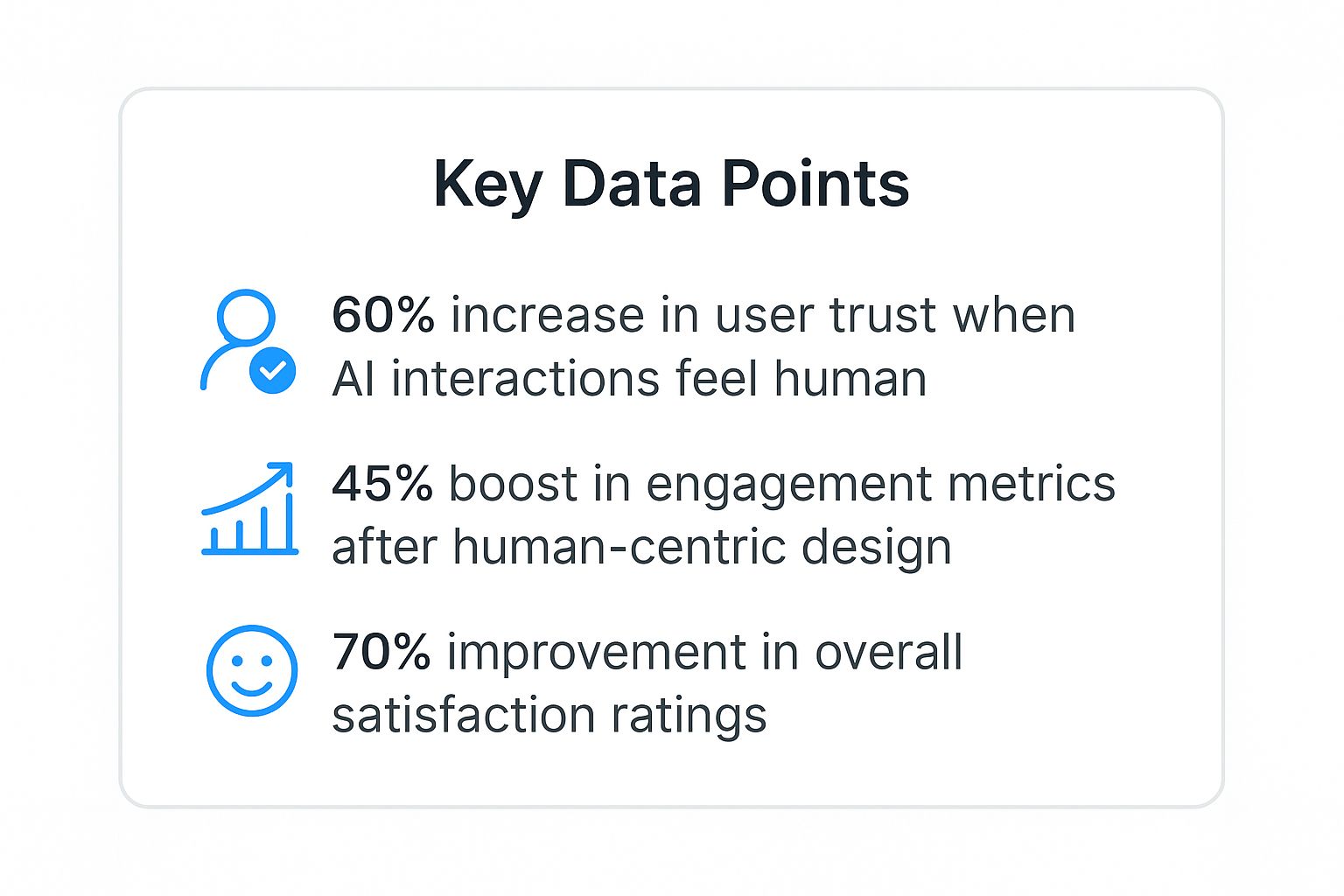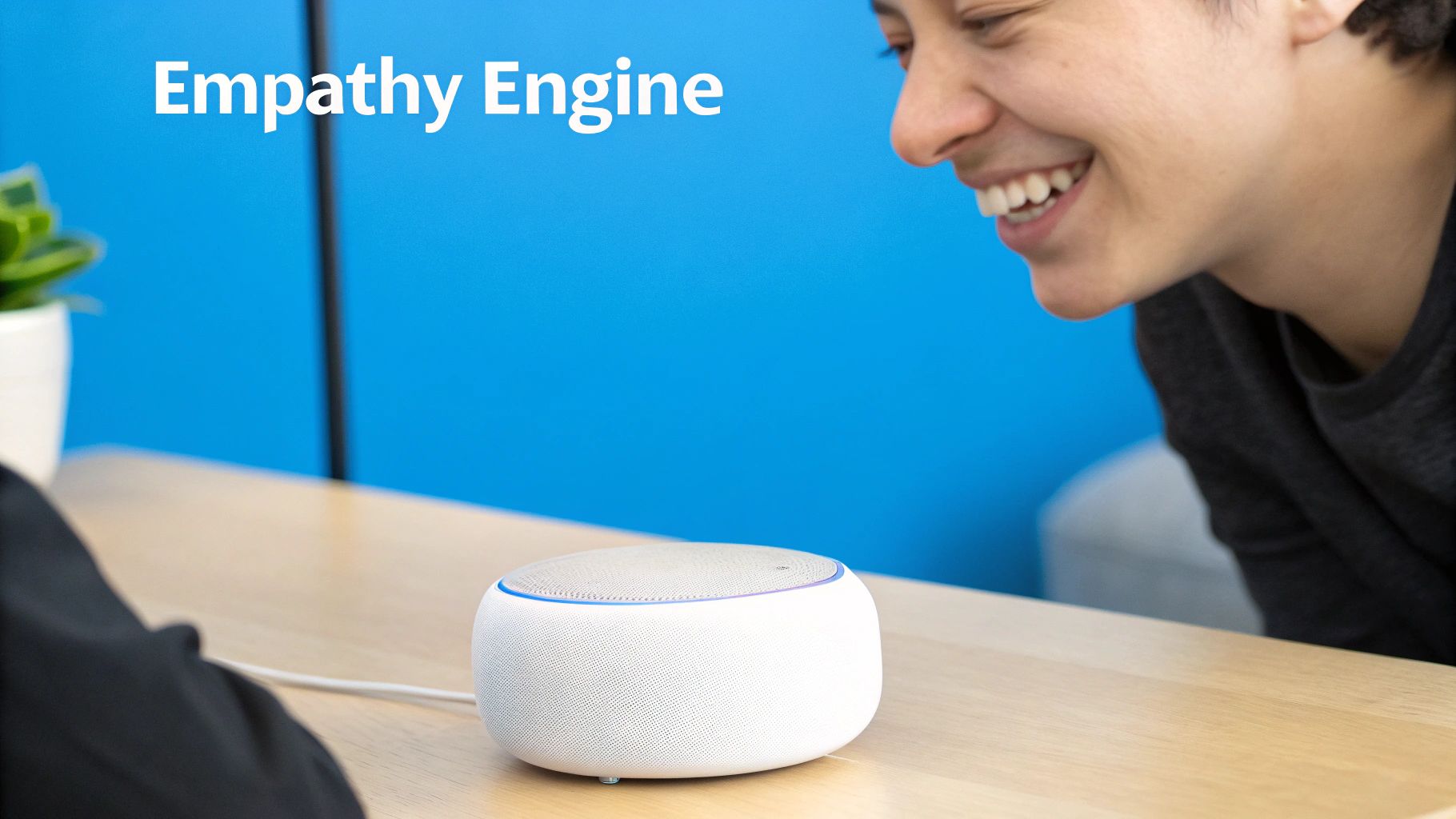How to Humanize AI Content That Actually Connects

So, what does it actually mean to "humanize" AI content? It’s all about taking that robotic, often generic output from an AI tool and transforming it into something that reads with real personality and insight. Think of it as an editing process, but specifically for adding a human touch. You're infusing personal stories, your unique brand voice, and a bit of emotional connection so the final piece actually resonates with people on a deeper level.
Why Human-Touched AI Content Performs Better
With nearly everyone using AI these days, making your content stand out is a bigger challenge than ever. While AI is a fantastic assistant for brainstorming and drafting, its raw output often lacks the very things that build a loyal audience: trust, personality, and a genuine connection.
Simply put, content that feels human performs better because it earns reader engagement, not just clicks. The data backs this up, showing clear benefits when you take the extra time to polish AI-generated text.
These numbers aren't just vanity metrics. A 60% increase in trust and a 45% boost in engagement are game-changers. It shows that audiences don't just prefer human-like content; they actively connect with it and value it more.
Establishing Trust and Authenticity
AI-generated content often sounds generic because it’s programmed to average out information from its massive training data. It can state facts perfectly well, but it can't share a personal experience or offer a unique takeaway.
This is where you come in. By adding your unique perspective, a few personal anecdotes, or some real-world examples, you create content that's not only original but also builds incredible credibility. Your voice is your brand's most valuable asset, and infusing it into AI drafts is the key to making it stick.
For a deeper dive into how this plays out in specific industries, check out a comprehensive guide to AI in education marketing and communications, a field where that human touch is absolutely critical for performance.
The Business Case for Humanization
The push for humanization isn't just about good writing; it's smart business. AI adoption has soared, but true mastery is still rare. This gap creates a massive opportunity for anyone willing to go the extra mile and refine their AI outputs.
The difference between raw AI text and a carefully humanized piece is stark. To illustrate, here’s a quick comparison of what to look for.
Raw AI Output vs. Humanized Content
| Characteristic | Raw AI Output | Humanized Content |
|---|---|---|
| Tone of Voice | Formal, neutral, often robotic. | Conversational, reflects brand personality. |
| Sentence Structure | Repetitive, predictable sentence patterns. | Varied, mixing short and long sentences for flow. |
| Personalization | Lacks personal stories or unique insights. | Includes anecdotes, opinions, and real-world examples. |
| Emotional Connection | Factual and detached. | Evokes emotion and connects with the reader. |
| Originality | Can feel generic or derivative of existing content. | Offers a unique perspective and fresh ideas. |
As you can see, the humanized version is designed to build a relationship with the reader, not just deliver information. Our own guide on how to humanize AI content walks you through the actionable steps to get there.
By elevating standard AI text with human insight, you create a superior asset that strengthens brand loyalty and drives better marketing results. It’s the difference between content that informs and content that influences.
Spotting Common AI Writing Habits
Before you can start to humanize AI text, you need to get good at spotting its tells. Think of it like a poker game—unedited AI content has certain habits that give its hand away. Learning to recognize these patterns is the first real step in turning a bland, robotic draft into something that actually connects with a reader.
A lot of AI tools default to a very formal, almost academic tone. They spit out sentences that are perfectly structured and grammatically correct, but they have no soul. There's no rhythm, no personality. It just feels sterile and keeps the reader at arm's length.
One of the biggest giveaways I see is the clumsy use of transition words. You'll see "Furthermore," "Moreover," or "Additionally" popping up all over the place. It's a dead-simple way for the machine to connect ideas, but it creates a predictable, monotonous flow that no human writer would ever use naturally.
Red Flags in AI-Generated Text
Think of this as your field guide for diagnosing "AI-ness." When you're looking over a draft, these are the red flags that scream a machine did most of the work.
- Too Much Passive Voice: Sentences like "The blog post was written by the AI" are a classic sign. An active voice is much more direct and confident—think "The AI wrote the blog post." It’s a small change with a big impact.
- Perfectly Uniform Paragraphs: Does every single paragraph have three sentences? Humans don't write like that. We mix it up, using short, punchy paragraphs for impact and longer ones to dig into the details.
- Overly Complicated Jargon: AI loves to sound smart by stuffing text with complex words when a simple one would do the job better. This just makes the content dense and hard to read.
Once you get good at spotting these habits, you can quickly see where a piece of content needs a human touch. The goal isn't just about fixing mistakes; it's about swapping out those robotic patterns for a genuine, conversational tone that your audience will actually enjoy reading.
Recognizing these tells is half the battle. For instance, an AI might write, "It is imperative that the subsequent steps are followed with precision." A quick human edit turns that into, "Next, follow these steps carefully." See the difference? That simple tweak completely changes the tone and makes it infinitely more readable, which is the whole point when you humanize AI content.
Injecting Your Authentic Voice and Perspective
Alright, you’ve spotted the tell-tale signs of a robot writer. Now for the fun part. This is where you roll up your sleeves and turn that bland, generic draft into something that sounds like you. The real goal isn't just to polish a few clunky sentences; it's to infuse your personality, expertise, and brand voice deep into the content.
Think of an AI draft as a coloring book sketch. The outlines are there, but it's flat and lifeless. You're the one who grabs the crayons—or, in this case, your keyboard—to add the color, depth, and detail that make it pop. This is how you truly humanize AI writing and forge a real connection with your audience.
Weave in Personal Stories and Examples
Nothing connects with a reader like sharing a real experience. This is your secret weapon, because an AI can't fake genuine stories. As you read through the draft, look for spots where a personal anecdote or a real-world example from your own work would fit perfectly.
Instead of a dry statement like, “Using this strategy improves efficiency,” get specific. Something like, "The first time I tried this method with a retail client, we saw their cart recovery rate jump by 25% in just two weeks. It was a lightbulb moment that showed me just how powerful one small change could be." See the difference? That little story adds a massive dose of credibility and makes the advice stick.
By grounding abstract concepts in real-life scenarios, you don't just tell the reader something is true—you show them. This is the essence of building trust and authority.
Swap Generic Language for Industry-Specific Terms
AI plays it safe, often using broad, one-size-fits-all language. Your job is to swap out those generic placeholders for the lingo your audience actually uses every day. It’s a powerful signal that you’re an insider who genuinely gets their world.
For example, an AI might spit out something about "improving customer happiness." You can instantly make that more authentic and valuable by using industry-native terms:
- Boosting Net Promoter Score (NPS)
- Reducing customer churn rate
- Enhancing the post-purchase experience
This kind of detail immediately tells the right reader that your content is for them. If you want a deeper dive, there are plenty of ways to humanize your AI-generated content that can help you nail the right tone. Ultimately, injecting your voice isn't just about sounding human—it's about proving you're an expert who's worth listening to.
Structuring Content for Readability and Flow
One of the biggest giveaways of AI-generated content is its structure. AI often spits out massive, dense paragraphs that are technically correct but an absolute nightmare for anyone trying to read them online. We don't read web content like a novel; we scan.
To humanize AI output, you have to think visually before you even worry about the words. The goal is to break up those intimidating "walls of text" and make the page feel inviting. Think about your own habits—you probably look for headings, bullet points, and short, punchy paragraphs to quickly gauge if an article is worth your time. Your readers are no different.
A surprisingly simple but effective trick is to keep your paragraphs short. Aim for one to three sentences, max. This creates a ton of white space around the text, which makes the content feel less dense and much easier to skim, especially on a phone.
Creating a Clear Visual Hierarchy
Short paragraphs are a great start, but you also need to guide the reader's eye through the content. This is where a clear visual hierarchy comes in. Human-written subheadings act as signposts, telling your reader what’s coming next and why they should care. Ditch the bland AI-generated titles like "Benefits of X" and write something that sparks curiosity.
Beyond that, you need to mix up your formatting. Using different visual elements keeps the reader engaged and helps highlight the most important bits of information.
- Bullet Points: Perfect for listing out features, ideas, or benefits when the order doesn't matter.
- Numbered Lists: Use these specifically for step-by-step instructions or anything that needs to be followed in a sequence.
- Blockquotes: Pull out a juicy statistic or a powerful quote. This gives it visual weight and makes it stand out.
The real goal here is to make the reading experience feel completely effortless. When you structure content well, you make complex information feel simple and show respect for your reader's time.
Getting this right isn't just about good design; it has a real economic impact. By 2025, it's estimated there will be 97 million people working in the AI sector, making the AI-human interaction a massive business. Just look at Netflix—they bring in an estimated $1 billion more each year by using AI to structure and personalize recommendations. You can find more stats on AI's growing economic role on ExplodingTopics.com.
Using Tools to Enhance Your Editing Workflow
Let's get one thing straight: humanizing AI content doesn't mean you have to go full luddite and ditch technology. That’s not a winning strategy. The smart move is to use the right tools to streamline your editing, not to replace your judgment.
Think of it this way: let software handle the tedious, repetitive stuff. That frees up your brainpower to focus on what truly matters—the high-value work that only a human can pull off.
I’ve found that using certain AI tools as a creative partner can be a game-changer. For example, a good paraphrasing tool can be a lifesaver when you’re stuck on a clunky sentence. It’s not about just hitting "spin," but about generating new angles to help you break through writer's block.
The productivity gains from this approach are pretty staggering. A 2025 report points to a $32 billion opportunity in the U.S. alone, driven by AI efficiency. Professionals who embrace AI are on track to save about 5 hours a week, which adds up to $19,000 in value per person each year. It’s a huge shift in how we work.
Choosing the Right Tools for the Job
The goal isn't to outsource your writing. It's to build a toolkit that acts like a highly efficient assistant, letting you focus on the creative heavy lifting.
- Paraphrasing Tools: These are fantastic for reworking those unmistakably robotic sentences or just brainstorming different ways to say something. We’ve got some great tips in our guide on how to edit AI-generated content for a human touch.
- Grammar and Tone Checkers: These go way beyond just catching typos. They can help you spot passive voice, simplify overly complex sentences, and smooth out any tonal weirdness.
- Platform-Specific AI: Some tools are built right into the platforms you already use. It's worth learning about options like using Divi AI to improve your website copy if you work within a specific ecosystem.
By letting tools handle the grunt work, you save your best creative energy for what actually connects with people: authentic stories, unique insights, and a genuine voice. That's the secret to working smarter, not just harder.
Common Questions About Humanizing AI Content
When you start working with AI-generated text, a few questions always seem to pop up. Let's walk through some of the most common ones I hear and get you some clear, practical answers.
One of the biggest worries is whether search engines penalize AI content. The short answer is no, not for being AI-generated. Google's real focus is on high-quality, helpful content, no matter how you create it. The problem is, raw, unedited AI text almost never hits that mark. It's often robotic and lacks real insight. When you humanize AI drafts, you're not just fooling a detector; you're adding unique value and improving the reader's experience, which is exactly what search algorithms want to see.
How Much Editing Is Enough?
This is the million-dollar question, and honestly, there's no magic number. A solid rule of thumb is to keep editing until the content truly sounds like your brand and gives readers something they can't get elsewhere. Ask yourself: does this sound like us? Does it share an experience or perspective that's uniquely ours?
The goal isn't just to sneak past an AI detector. It's to craft something you're genuinely proud to attach your name to. You know you're done editing when the text feels authentic, demonstrates real expertise, and actually connects with your audience.
Another major question is about the ethics of using AI. The most ethical way to approach it is to think of AI as your assistant, not your replacement. It's a tool to get the first draft down, not to do your thinking for you. Always be transparent where it matters, double-check every fact the AI gives you, and make sure the final piece is a true reflection of your own knowledge. Using AI responsibly means you own the final product, period.
If you're looking for a deeper dive into the how-to, you can explore various tools and strategies to humanize AI writing that will make the whole process much smoother. At the end of the day, the winning formula is combining AI's efficiency with your irreplaceable human touch. That's how you create content that's both effective and trustworthy.
Ready to turn those robotic drafts into content that actually connects and converts? Word Spinner is your all-in-one platform for humanizing, rewriting, and creating original text that flies past AI detectors and resonates with real people. Start your free trial today and see how much smarter your writing process can be.



